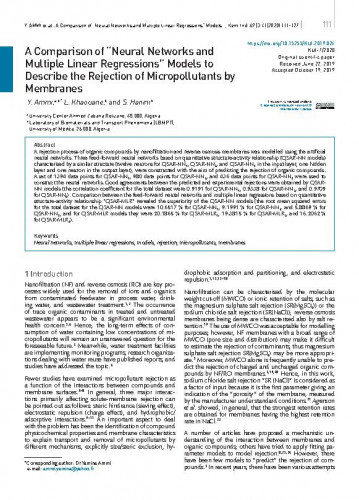A rejection process of organic compounds by nanofiltration and reverse osmosis membranes was modelled using the artificial neural networks. Three feed-forward neural networks based on quantitative structure-activity relationship (QSAR-NN models) characterised by a similar structure (twelve neurons for QSAR-NN1, QSAR-NN2, and QSAR-NN3 in the input layer, one hidden layer and one neuron in the output layer), were constructed with the aim of predicting the rejection of organic compounds. A set of 1394 data points for QSAR-NN1, 980 data points for QSAR-NN2, and 436 data points for QSAR-NN3 were used to construct the neural networks. Good agreements between the predicted and experimental rejections were obtained by QSAR-NN models (the correlation coefficient for the total dataset were 0.9191 for QSAR-NN1, 0.9338 for QSAR-NN2, and 0.9709 for QSAR-NN3). Comparison between the feed-forward neural networks and multiple linear regressions based on quantitative structure-activity relationship “QSAR-MLR” revealed the superiority of the QSAR-NN models (the root mean squared errors for the total dataset for the QSAR-NN models were 10.6517 % for QSAR-NN1, 9.1991 % for QSAR-NN2, and 5.8869 % for QSAR-NN3, and for QSAR-MLR models they were 20.1865 % for QSAR-MLR1, 19.3815 % for QSAR-MLR2, and 16.2062 % for QSAR-MLR3).; Postupak odbacivanja organskih spojeva nanofiltracijom i membranama reverzne osmoze modeliran je umjetnim neuronskim mrežama. Konstruirane su tri neuronske mreže zasnovane na kvantitativnom odnosu strukture-aktivnosti (QSAR-NN modeli) karakterizirane sličnom strukturom (dvanaest neurona za QSAR-NN1, QSAR-NN2 i QSAR-NN3 u ulaznom sloju, jedan skriveni sloj i jedan neuron u izlaznom sloju), s ciljem predviđanja odbacivanja organskih spojeva. Za izgradnju neuronskih mreža upotrijebljeni su skupovi od 1394 podatkovnih točaka za QSAR-NN1, 980 podatkovnih točaka za QSAR-NN2 i 436 podatkovnih točaka za QSAR-NN3. Dobre usklađenosti između predviđenih i eksperimentalnih odbacivanja dobivene su modelima QSAR-NN (korelacijski koeficijent za ukupni skup podataka bio je 0,9191 za QSAR-NN1, 0,9338 za QSAR-NN2 i 0,9709 za QSAR-NN3). Usporedba neuronskih mreža i višestrukih linearnih regresija zasnovanih na kvantitativnom odnosu struktura-aktivnost “QSAR-MLR” otkrila je superiornost modela QSAR-NN (korijenske srednje kvadratne pogreške za ukupni skup podataka za modele QSAR-NN bile su 10,6517 % za QSAR-NN1, 9,1991 % za QSAR-NN2, i 5,8869 % za QSAR-NN3, a za modele QSAR-MLR 20,1865 % za QSAR-MLR1, 19,3815 % za QSAR-MLR2, i 16,2062 % za QSAR-MLR3).
Sažetak

 Kemija u industriji : 69,3/4 (2020) / glavni i odgovorni urednik Nenad Bolf.
Kemija u industriji : 69,3/4 (2020) / glavni i odgovorni urednik Nenad Bolf.